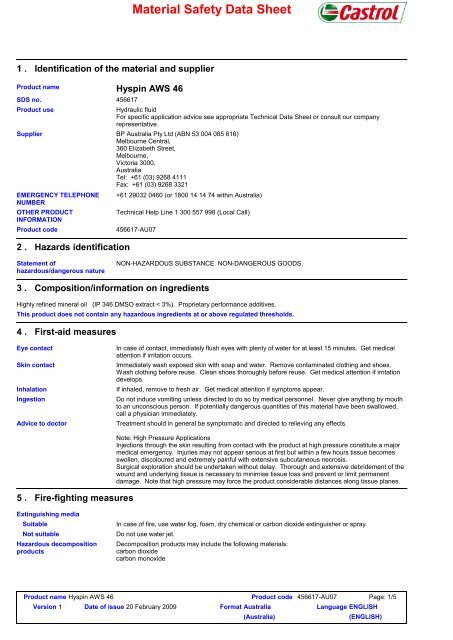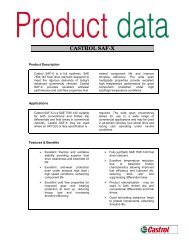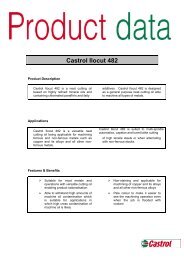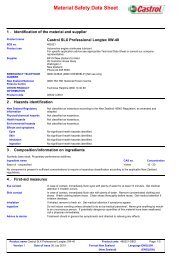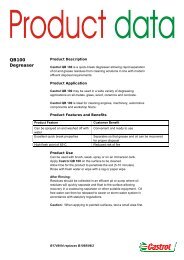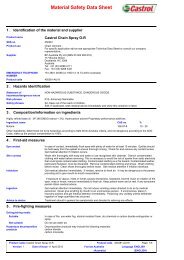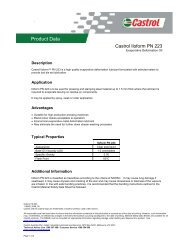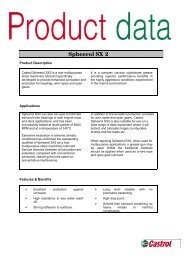Material Safety Data Sheet - Industrial Lubricants & Services Limited
Material Safety Data Sheet - Industrial Lubricants & Services Limited
Material Safety Data Sheet - Industrial Lubricants & Services Limited
You also want an ePaper? Increase the reach of your titles
YUMPU automatically turns print PDFs into web optimized ePapers that Google loves.
<strong>Material</strong> <strong>Safety</strong> <strong>Data</strong> <strong>Sheet</strong><br />
1 . Identification of the material and supplier<br />
Product name<br />
SDS no.<br />
Product use<br />
Supplier<br />
EMERGENCY TELEPHONE<br />
NUMBER<br />
OTHER PRODUCT<br />
INFORMATION<br />
Product code<br />
Hyspin AWS 46<br />
456617<br />
Hydraulic fluid<br />
For specific application advice see appropriate Technical <strong>Data</strong> <strong>Sheet</strong> or consult our company<br />
representative.<br />
BP Australia Pty Ltd (ABN 53 004 085 616)<br />
Melbourne Central,<br />
360 Elizabeth Street,<br />
Melbourne,<br />
Victoria 3000,<br />
Australia<br />
Tel: +61 (03) 9268 4111<br />
Fax: +61 (03) 9268 3321<br />
+61 29032 0460 (or 1800 14 14 74 within Australia)<br />
Technical Help Line 1 300 557 998 (Local Call)<br />
456617-AU07<br />
2 .<br />
Hazards identification<br />
Statement of<br />
hazardous/dangerous nature<br />
NON-HAZARDOUS SUBSTANCE. NON-DANGEROUS GOODS.<br />
3 .<br />
Composition/information on ingredients<br />
Highly refined mineral oil (IP 346 DMSO extract < 3%). Proprietary performance additives.<br />
This product does not contain any hazardous ingredients at or above regulated thresholds.<br />
4 .<br />
First-aid measures<br />
Eye contact<br />
Skin contact<br />
Inhalation<br />
Ingestion<br />
Advice to doctor<br />
In case of contact, immediately flush eyes with plenty of water for at least 15 minutes. Get medical<br />
attention if irritation occurs.<br />
Immediately wash exposed skin with soap and water. Remove contaminated clothing and shoes.<br />
Wash clothing before reuse. Clean shoes thoroughly before reuse. Get medical attention if irritation<br />
develops.<br />
If inhaled, remove to fresh air. Get medical attention if symptoms appear.<br />
Do not induce vomiting unless directed to do so by medical personnel. Never give anything by mouth<br />
to an unconscious person. If potentially dangerous quantities of this material have been swallowed,<br />
call a physician immediately.<br />
Treatment should in general be symptomatic and directed to relieving any effects.<br />
Note: High Pressure Applications<br />
Injections through the skin resulting from contact with the product at high pressure constitute a major<br />
medical emergency. Injuries may not appear serious at first but within a few hours tissue becomes<br />
swollen, discoloured and extremely painful with extensive subcutaneous necrosis.<br />
Surgical exploration should be undertaken without delay. Thorough and extensive debridement of the<br />
wound and underlying tissue is necessary to minimise tissue loss and prevent or limit permanent<br />
damage. Note that high pressure may force the product considerable distances along tissue planes.<br />
5 .<br />
Fire-fighting measures<br />
Extinguishing media<br />
Suitable<br />
Not suitable<br />
Hazardous decomposition<br />
products<br />
In case of fire, use water fog, foam, dry chemical or carbon dioxide extinguisher or spray.<br />
Do not use water jet.<br />
Decomposition products may include the following materials:<br />
carbon dioxide<br />
carbon monoxide<br />
Product name Hyspin AWS 46<br />
Product code 456617-AU07<br />
Page: 1/5<br />
Version 1 Date of issue 20 February 2009<br />
Format Australia<br />
(Australia)<br />
Language ENGLISH<br />
(ENGLISH)
Unusual fire/explosion<br />
hazards<br />
This material is not explosive as defined by established regulatory criteria.<br />
Special fire-fighting<br />
procedures<br />
Protection of fire-fighters<br />
None identified.<br />
Fire-fighters should wear positive pressure self-contained breathing apparatus (SCBA) and full turnout<br />
gear.<br />
6 . Accidental release measures<br />
Personal precautions<br />
Environmental precautions<br />
Large spill<br />
Small spill<br />
No action shall be taken involving any personal risk or without suitable training. Evacuate surrounding<br />
areas. Keep unnecessary and unprotected personnel from entering. Do not touch or walk through<br />
spilt material. Put on appropriate personal protective equipment (see section 8).<br />
Avoid dispersal of spilt material and runoff and contact with soil, waterways, drains and sewers. Inform<br />
the relevant authorities if the product has caused environmental pollution (sewers, waterways, soil or<br />
air).<br />
Stop leak if without risk. Move containers from spill area. Prevent entry into sewers, water courses,<br />
basements or confined areas. Wash spillages into an effluent treatment plant or proceed as follows.<br />
Contain and collect spillage with non-combustible, absorbent material e.g. sand, earth, vermiculite or<br />
diatomaceous earth and place in container for disposal according to local regulations (see section 13).<br />
Dispose of via a licensed waste disposal contractor. Note: see section 1 for emergency contact<br />
information and section 13 for waste disposal.<br />
Stop leak if without risk. Move containers from spill area. Dilute with water and mop up if watersoluble<br />
or absorb with an inert dry material and place in an appropriate waste disposal container.<br />
Dispose of via a licensed waste disposal contractor.<br />
7 .<br />
Handling and storage<br />
Handling<br />
Storage<br />
Avoid prolonged or repeated contact with skin. Wash thoroughly after handling.<br />
Keep container tightly closed. Keep container in a cool, well-ventilated area.<br />
Combustibility Classification Combustible liquid Class C2 (AS 1940).<br />
8 . Exposure controls/personal protection<br />
Ingredient name<br />
Base oil - unspecified<br />
Biological Limit Values<br />
Occupational exposure<br />
controls<br />
Hygiene measures<br />
Personal protective equipment<br />
Respiratory protection<br />
Skin and body<br />
Hand protection<br />
No biological limit allocated.<br />
Occupational exposure limits<br />
NOHSC (Australia).<br />
TWA: 5 mg/m³ 8 hour(s). Form: Oil mist, mineral<br />
Whilst specific OELs for certain components are included in this SDS, it should be noted that other components of the preparation will be<br />
present in any mist, vapour or dust produced. For this reason, the specific OELs may not be applicable to the product and are provided<br />
for guidance purposes.<br />
Exposure controls<br />
Provide exhaust ventilation or other engineering controls to keep the airborne concentrations of<br />
vapours below their respective occupational exposure limits.<br />
Wash hands, forearms and face thoroughly after handling chemical products, before eating, smoking<br />
and using the lavatory and at the end of the working period.<br />
Avoid breathing of vapours, mists or spray. Select and use respirators in accordance with AS/NZS<br />
1715/1716. When mists or vapours exceed the exposure standards then the use of the following is<br />
recommended: Approved respirator with organic vapour and dust/mist (Type P1) filters. Filter<br />
capacity and respirator type depends on exposure level.<br />
Avoid prolonged or repeated contact with skin. Wear protective clothing if prolonged or repeated<br />
contact is likely.<br />
Wear protective gloves if prolonged or repeated contact is likely. Chemical-resistant gloves.<br />
Recommended: nitrile gloves.<br />
The correct choice of protective gloves depends upon the chemicals being handled, the conditions of<br />
work and use, and the condition of the gloves (even the best chemically resistant glove will break<br />
down after repeated chemical exposures). Most gloves provide only a short time of protection before<br />
they must be discarded and replaced. Because specific work environments and material handling<br />
practices vary, safety procedures should be developed for each intended application. Gloves should<br />
therefore be chosen in consultation with the supplier/manufacturer and with a full assessment of the<br />
working conditions.<br />
Eye protection<br />
<strong>Safety</strong> glasses with side shields.<br />
Product name Hyspin AWS 46<br />
Product code 456617-AU07<br />
Page: 2/5<br />
Version 1 Date of issue 20 February 2009<br />
Format Australia<br />
(Australia)<br />
Language ENGLISH<br />
(ENGLISH)
9 .<br />
Physical and chemical properties<br />
Physical state<br />
Colour<br />
Odour<br />
Flash point<br />
Vapour pressure<br />
Vapour density<br />
pH<br />
Boiling point / range<br />
Melting point / range<br />
Liquid.<br />
Light Amber.<br />
Mild<br />
Pour point -24 °C<br />
Relative density/Specific<br />
gravity<br />
Density<br />
Solubility<br />
200 °C (Closed cup) Pensky-Martens.<br />
Not available.<br />
Not available.<br />
Viscosity Kinematic: 46 mm 2 /s (46 cSt) at 40°C<br />
Kinematic: 6.65 mm 2 /s (6.65 cSt) at 100°C<br />
10 . Stability and reactivity<br />
Not available.<br />
Not available.<br />
Not available.<br />
Not available.<br />
876 kg/m 3 (0.876 g/cm 3 ) at 15°C<br />
insoluble in water.<br />
Stability<br />
Conditions to avoid<br />
Incompatibility with various<br />
substances/Hazardous<br />
Reactions<br />
Hazardous decomposition<br />
products<br />
The product is stable.<br />
Avoid extreme temperatures, strong oxidizers, fire.<br />
Reactive or incompatible with the following materials: oxidizing materials.<br />
Decomposition products may include the following materials:<br />
carbon dioxide<br />
carbon monoxide<br />
11 . Toxicological information<br />
Effects and symptoms<br />
Eyes<br />
Skin<br />
Inhalation<br />
Ingestion<br />
Chronic toxicity<br />
Carcinogenic effects<br />
Mutagenic effects<br />
12 . Ecological information<br />
No significant health hazards identified.<br />
Prolonged or repeated contact can defat the skin and lead to irritation and/or dermatitis.<br />
No significant health hazards identified.<br />
No significant health hazards identified.<br />
No component of this product at levels greater than or equal to 0.1% is identified as a carcinogen by<br />
ACGIH, the International Agency for Research on Cancer (IARC), the European Commission (EC), or<br />
the National Occupational Health and <strong>Safety</strong> Commission (Australia).<br />
No known significant effects or critical hazards.<br />
Ecotoxicity<br />
Biodegradability<br />
Persistence/degradability<br />
Not classified as environmentally hazardous in accordance with the ‘Approved Criteria for Classifying<br />
Hazardous Substances’ [NOHSC (1008)/2004 as amended and adapted].<br />
The biodegradability of this material has not been determined.<br />
13 . Disposal considerations<br />
Disposal considerations /<br />
Waste information<br />
Special Precautions for<br />
Landfill or Incineration<br />
The generation of waste should be avoided or minimised wherever possible. Empty containers or<br />
liners may retain some product residues. This material and its container must be disposed of in a safe<br />
way. Dispose of surplus and non-recyclable products via a licensed waste disposal contractor.<br />
Disposal of this product, solutions and any by-products should at all times comply with the<br />
requirements of environmental protection and waste disposal legislation and any regional local<br />
authority requirements. Avoid dispersal of spilt material and runoff and contact with soil, waterways,<br />
drains and sewers.<br />
No additional special precautions identified.<br />
Product name Hyspin AWS 46<br />
Product code 456617-AU07<br />
Page: 3/5<br />
Version 1 Date of issue 20 February 2009<br />
Format Australia<br />
(Australia)<br />
Language ENGLISH<br />
(ENGLISH)
14 . Transport information<br />
International transport regulations<br />
Not classified as dangerous for transport (ADG, IMDG, ICAO/IATA).<br />
Special precautions for user<br />
15 . Regulatory information<br />
Standard for the Uniform Scheduling of Drugs and Poisons<br />
Not regulated.<br />
Control of Scheduled Carcinogenic Substances<br />
Ingredient name<br />
No Listed Substance<br />
Other regulations<br />
Europe inventory<br />
United States inventory<br />
(TSCA 8b)<br />
Australia inventory (AICS)<br />
Canada inventory<br />
China inventory (IECSC)<br />
Japan inventory (ENCS)<br />
Korea inventory (KECI)<br />
Philippines inventory<br />
(PICCS)<br />
16 . Other information<br />
No known special precautions required. See Section: "Handling and storage" for additional<br />
information.<br />
All components are listed or exempted.<br />
All components are listed or exempted.<br />
All components are listed or exempted.<br />
All components are listed or exempted.<br />
All components are listed or exempted.<br />
All components are listed or exempted.<br />
All components are listed or exempted.<br />
All components are listed or exempted.<br />
Schedule<br />
Key to abbreviations<br />
AMP = Acceptable Maximum Peak<br />
ACGIH = American Conference of Governmental <strong>Industrial</strong> Hygienists, an agency that promulgates<br />
exposure standards.<br />
ADG = Australian Code for the Transport of Dangerous Goods by Road and Rail<br />
ADG Code = Australian Code for the Transport of Dangerous Goods by Road and Rail<br />
CAS Number = Chemical Abstracts Service Registry Number<br />
HAZCHEM Code = Emergency action code of numbers and letters which gives information to<br />
emergency services. Its use is required by the ADG Code for Dangerous Goods in bulk.<br />
ICAO = International Civil Aviation Organization.<br />
IATA = International Air Transport Association, the organization promulgating rules governing<br />
shipment of goods by air.<br />
IMDG = International Maritime Organization Rules, rules governing shipment of goods by water.<br />
IP 346 = A chemical screening assay for dermal toxicity. The European Commission has<br />
recommended that Method IP 346 be used as the basis for labelling certain lubricant oil base stocks<br />
for carcinogenicity. The EU Commission has stipulated that the classification as a carcinogen need<br />
not apply if it can be shown that the substance contains less than 3% DMSO extract as measured by<br />
IP 346. (See Note L, European Commission Directive 67/548/EEC as amended and adapted.) DMSO<br />
is a solvent.<br />
NOHSC = National Occupational Health & <strong>Safety</strong> Commission, Australia<br />
TWA = Time weighted average<br />
STEL = Short term exposure limit<br />
UN Number = United Nations Number, a four digit number assigned by the United Nations Committee<br />
of Experts on the Transport of Dangerous Goods.<br />
History<br />
Date of issue<br />
Date of previous issue<br />
Prepared by<br />
Notice to reader<br />
20/02/2009.<br />
No previous validation.<br />
Product Stewardship<br />
All reasonably practicable steps have been taken to ensure this data sheet and the health, safety and environmental information<br />
contained in it is accurate as of the date specified below. No warranty or representation, express or implied is made as to the accuracy or<br />
completeness of the data and information in this data sheet.<br />
The data and advice given apply when the product is sold for the stated application or applications. You should not use the product other<br />
than for the stated application or applications without seeking advice from us.<br />
It is the user’s obligation to evaluate and use this product safely and to comply with all applicable laws and regulations. The BP Group<br />
shall not be responsible for any damage or injury resulting from use, other than the stated product use of the material, from any failure to<br />
adhere to recommendations, or from any hazards inherent in the nature of the material. Purchasers of the product for supply to a third<br />
party for use at work, have a duty to take all necessary steps to ensure that any person handling or using the product is provided with the<br />
information in this sheet. Employers have a duty to tell employees and others who may be affected of any hazards described in this sheet<br />
Product name Hyspin AWS 46<br />
Product code 456617-AU07<br />
Page: 4/5<br />
Version 1 Date of issue 20 February 2009<br />
Format Australia<br />
(Australia)<br />
Language ENGLISH<br />
(ENGLISH)
and of any precautions that should be taken.<br />
Product name Hyspin AWS 46<br />
Product code 456617-AU07<br />
Page: 5/5<br />
Version 1 Date of issue 20 February 2009<br />
Format Australia<br />
(Australia)<br />
Language ENGLISH<br />
(ENGLISH)


